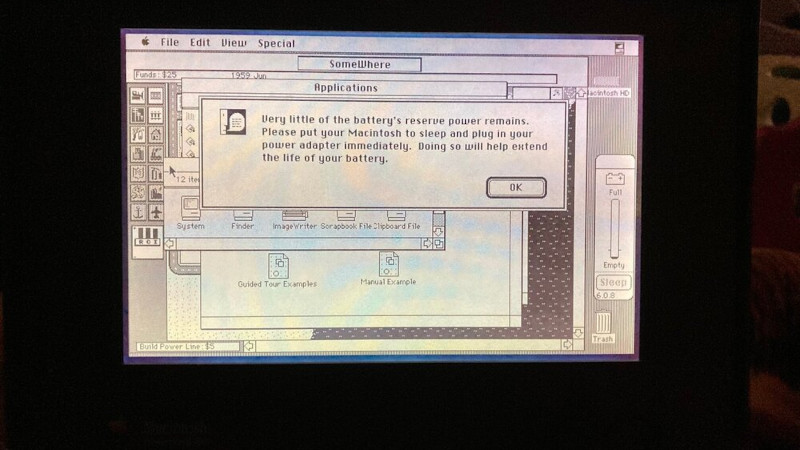The PowerBook 100 was one of the earliest Apple laptops released, coming not long after the breakout Macintosh Portable. Unlike modern hardware, it relied on sealed lead acid batteries. [360alaska] has such a laptop whose original battery is long dead, so they set about building a replacement battery with lithium cells instead.
The battery and its associated support circuitry is a mite unconventional in its design, but it gets the job done. The build uses two lithium polymer pouch cells in place of the original four cell sealed-lead acid battery, to replicate the roughly 7.2V nominal voltage. Because of this, unfortunately the stock PowerBook charger can’t provide enough voltage to fully charge the LiPo cells up to their full 8.4 volts.
The workaround selected is that when the batteries fall below 80% state of charge, relays disconnect the cells from their series configuration powering the laptop, and instead connect each cell to its own single-cell charger board. Once charging is complete, the relays switch back out of charging mode so the batteries power the laptop once more. The only major drawback is that withdrawing the power adapter while the batteries are on charge will cut all power to the laptop.
It may not be perfect, but [360alaska] has succeeded in building a drop-in battery solution for the PowerBook 100 that can be used with the stock charger. Laptop batteries can be a fraught thing to deal with; often there are safeguards or DRM-type issues to navigate to get them to work around. Sometimes open-source designs are the best solution out there.















Back when laptops could run off AC AND charge at the same time!
I love seeing folk go to such efforts to keep machines like this alive. Emulation is fun and all, but nothing like the real thing, and someone’s valuing the real thing… when yahs go to a museum, do you want to see the Mona Lisa on a kiosk’s LCD? But, unlike the Mona Lisa, it’s nice to think that by doing something like this /everyone/ involved in making it gets to have a place in history, including even the janitors who cleaned the bathrooms at the plastic plant.
Laptops, ultra books, and some tablets can still be used and substantially charge the battery at the same time. It’s only some gaming laptops that have this problem.
Well with laptops becoming classic computers (Well laptops with batteries) this is going to become more common in the future.
I’m still using a 2014 MacBook Pro 15″ Retina, and have been trying & struggling to replace the battery since September 2020. The first replacement battery killed my logic board.
Since starting a new job in January 2021, I’ve had access to an oscilloscope and logic analyser, and have since tried 3 more batteries.
Good batteries idle at 2.2V, then “wake up” to 12V.
Fake, safe batteries idle at 6.75V.
Fake, dangerous batteries idle a 12V.
It killed my logic board when waking from sleep on battery, causing a power surge.
There will be a whole writeup coming when I have a solution, but I’ve been making good use of Charlie Miller’s Battery Firmware Hacking PDF, trying to fuzz the unseal code, and sourcing more tools (TI EV2300, CP2112) & chips to try to hack the TI BQ20Z451.
In the meantime, if you have a swollen battery – don’t throw it away, don’t replace it, don’t disconnect the cells. Just live with it. I doubt that Apple will provide replacement legacy batteries until there’s been a lawsuit from houses burning down.
Strange behaviour, a 12V battery “idling” at 2,2V? Normally a battery should provide it’s voltage at it’s terminals and any power conditioning/regulation is best done in the electronics of the supplied device.
12 inch g4 power book checking in. First Mac and longest lasting. Runs Linux like a dream too! I’ve been thinking about using it as a ‘secure’ system to store keys and stuff since it’s PPC. Am I nuts? I’d put a fresh drive in first…
An alternative method could have been to use 5V isolated DC-DC modules to drive the individual charger chips. Then there is no need to disconnect the batteries, and they can still be charged individually.
It is using a 5v DCDC, but that’s not enough to charge them together.
So Apple products don’t brick themselves the moment they are opened? If not, it’s coming.
My first laptop was a second-hand PowerBook 100, bought in 1996, and I loved it despite the relatively slow CPU (effectively about 50% faster than a Mac Plus despite being ’16MHz’) and tiny HD (20Mb).
I’d been accepted for a Masters in Computer Architecture at Manchester University and popped over in the summer to find some accommodation. On the last day I was browsing through “Computer Shopper” (or MicroMart) at WHSmith in the Arndale centre and saw a PB100 I could pick up en-route back home. That shop was about 20 metres away from where the 1.5 tonne Manchester IRA bomb was detonated just a couple of weeks later.
Sadly, it looks like that forum thread was lost in a database corruption a couple weeks after this post,. It’s archived on the Wayback machine, but none of the images were saved.
https://68kmla.org/bb/index.php?threads/lithium-polymer-battery-for-pb100-and-maybe-portable.3584/page-3